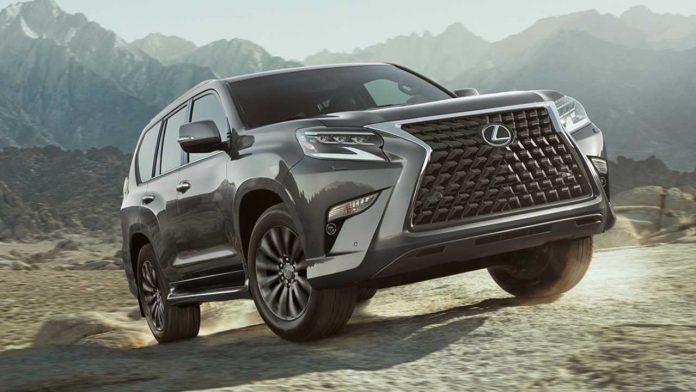If you want to really go off-road – as opposed to off into the grass – and be really comfortable – without being too big – there aren’t many options.
Which makes it easy for Lexus to sell the GX460 to people looking for all of that in one reasonably sized package
The GX460 is an extremely off-road-capable mid-sized/three-row SUV that is also an extremely luxurious SUV.
It is built rugged – with a girder-like perimeter steel frame onto which the body is bolted. The frame doesn’t flex – and is very hard to hurt – which is part of what makes this Lexus able to go severely off-road and come back tracking straight. The frame won’t bend even if half of the weight of the vehicle isn’t supported by tire contact with the ground – as when crawling over rocks.
The doors will still close right when you’re back on the ground, too.
And when you’re back on pavement, you’ll be in a Lexus. One that’s available with a power-reclining third row – a feature that’s hard to find in anything this size this capable and this luxurious.
Prices start at $53,000 for the base trim and top out at $64,265 for the . . . Luxury trim, which comes standard with a real wood-trimmed heated steering wheel – as well as an auto-leveling suspension and the power-reclining third row. 
Both trims come standard with V8 power – and driver-selectable full-time four-wheel-drive with Low range gearing.
What’s New
The GX gets a new front clip with a larger ”cowcatcher” grille and a heavy-duty off-road package which includes a low-speed rock-crawl mode plus underbody skid plates and a transmission oil cooler to help you get there – and get back.
What’s Good
One of the very few body-on-frame/solid rear axle mid-size SUVs you can still buy new.
The only luxury-brand body-on-frame/solid rear axle mid-size/three-row SUV you can still buy new.
V8 is standard in all trims.
What’s Not So Good
Both the low-speed crawl control system and the 17-speaker Mark Levinson audio system are available only with the much higher-cost Luxury trim.
Third row is vestigial.
With third row up, cargo space is vestigial.
The GX is an anachronism – in a good way.
In several ways.
It is one of the few SUVs in its class that still comes standard with a V8 – and without direct injection, which involves two fuel pumps, very high fuel pressure and the possibility of carbon-fouled intake valves at some point down the road.
To address this possibility, many of the latest direct-injected engines have had a dedicated port-fuel-injection circuit added, the sole purpose of which is to spritz the backsides of the intake valves with gas – which acts as a solvent – in order to forestall the accumulation of crud. Which, over time, causes poor intake valve sealing – a problem you don’t want.
But now you’ve got two fuel-injection systems – one to fuel the engine, the other to correct for problems caused by the first injection system.
Guess who pays to avoid this problem?
This Lexus had just one fuel-delivery system – and it will never foul the intake valves with crud, because it’s not a direct-injection system.
There’s just one fuel pump, too.
The V8 – which displaces 4.6 liters – produces 301 horsepower and 329 ft.-lbs. of torque, without DI – and without boost. Rivals like the Land Rover Discovery come standard with smaller engines – in the case of the Disco, a 3.0 liter V6 – with their lack of displacement compensated for by a turbo or (in the Disco’s case) a supercharger – which does the same thing as a turbo.
Both force-feed air to the engine, pressurizing the cylinders to increase cylinder pressure and thus, the force of the eventual combustion event. This makes a smaller engine produce the power of a larger engine – but in the same way that steroids make a body builder bigger.
There is a cost – in the case of the turbo/supercharged engine, it comes in the form of additional parts and more complicated systems – which can mean more expense down the road when something breaks – as well as the pressure on the engine, which can lead to the same.
A larger engine can make equivalent power without the parts or the stress. The cost here is gas – which the larger engine will use more of.
But not much more – at least in this case.
An interesting thing about the GX’s V8 is that it barely uses more gas than more “up to date” direct-injected (and smaller and boosted to make up for that) engines like the supercharged 3.0 liter V6 that’s standard in the Land Rover Discovery – which the EPA says delivers 16 city, 21 highway vs. the GX’s 15 city, 19 highway – a difference that falls within the margin of error.
This is interesting because higher fuel economy is presented as the chief reason for the use of direct-injection and smaller-and-boosted engines. It seems like a lot of trouble – and expense – to go to for the sake of 2 or so MPG, if that.
Which it is, were it not for the government. It is government pressure that is force-feeding both DI and turbo-boosted smaller engines to the car (and SUV) buying public, via regulations that apply pressure to achieve ever higher fuel economy numbers as well as ever-lower emissions numbers.
But the differences are angels-dancing-on-the-head-of-a-pin differences . . . to the buyer, who gets to pay for it all.
The Disco’s supercharged V6 is a bit stronger – the blower inflates the output of the little engine to 340 horsepower and 332 ft.-lbs. of torque. But what would the output of the GX’s V8 be if boosted?
And even so, the force-fed Disco is only marginally quicker in addition to being only slightly more fuel-efficient: Zero to 60 in about 7 seconds flat vs. 7.4 for the V8 GX. It’s a difference – but like the MPG difference – not much of one.
The GX’s V8 is paired with a six-speed automatic and full-time 4WD with a two-speed transfer case and 4WD Low gearing.
The standard six-speed automatic has a second gear start feature, too – plus Hill Descent Control. With the optional suspension, the body can raised or lowered at the push of a button.
Every GX can pull up to a 6,500 lb. trailer.
Most SUVs have gone unibody – the body and frame are a welded-together piece – because it saves weight vs. having a separate steel frame onto which the body is bolted. The unibody layout also helps with rigidity; there’s less potential for the body to move in relation to the frame – because they’re welded together.
But, nothing rides like body-on-frame. Which is why most big luxury cars and most SUVs used to almost always be made this way. They aren’t anymore – most of them – because of the pressure from the government.
The heavy steel frame – and the road below it – are separated from the body (and the passengers from the road) via a number of rubber biscuits in between the frame and the body, which tamp down/isolate the road – and its imperfections – from the passengers inside the body.
The sensation is wonderfully solid – and muted. The qualities that used to define luxury cars and which luxury SUVs used to offer, too.
This one still does.
And for serious off-roading, it’s hard to beat body-on-frame . . . because it’s hard to break.
Same goes for the GX’s solid rear axle – which also doesn’t hop on rutted gravel roads. The chief reason for four-wheel-independent suspension isn’t handling; it is to smooth out the ride. This Lexus has the toughness of the solid axle rear without the clunky ride that sometimes goes along for the ride.
It also doesn’t feel as wide – because it’s not.
And this, too, is an aspect of the GX’s off-road curriculum vitae. It is based on the Toyota 4Runner, which is narrow through the hips – which is a virtue when you’re off-road and the road has trees and ledges on either side. You can thread the needle – slowly – through tight spots that would stymie larger (and wider) SUVs.
And also-same sized SUVs like the Discovery, which is 78.7 inches wide vs. 74.2 inches for the GX.
And that is a difference that matters when the off-roading gets tight.
At the Curb

The mid-sized GX comes standard with a third row – it’s optional (and extra cost) in same-sized rivals like the Land Rover Discovery.
And the GX is not as huge as full-size/three row luxury SUVs like the Infiniti QX80 and GMC Sierra., which are both much longer as well as much wider.
The catch is there’s not much legroom back there – and because it is there, there’s not much cargo space behind there. With its third row up, the GX has just 11.6 cubic feet of cargo capacity; the good news is this can be expanded to 64.7 cubic feet by lowering the seats.
On the way home from rock-crawling you can listen to the GX’s available 17-speaker Mark Levinson audio system – which is essentially identical to the audio system in Lexus’ top-of-the line sedan – the LS500 – which you can’t take rock crawling.
You can adjust the audio system using rotary knobs, too – another pleasantly anachronistic aspect of the GX.
But be careful where you point that front clip.
The Lexus cowcatcher grille just forward like Mussolini’s chin – and it’s made of plastic – as is true of most new car (and SUV) faces. Car (and SUV) designers love plastic because it can be cost-effectively molded into almost any shape and since government pressure has greatly limited the overall shape of all new vehicles – all of which must comply with the same government saaaaaaaaaaaaafety regs – one of the few remaining areas for creative expression is the front end.
But plastic is also fragile – and Lexus plastic is expensive.
Toyota offers a detachable front sway bar set-up for the 4Runner to provide greater front suspension articulation off-roading. Lexus might give thought to a detachable grille that could be put in the cargo area before heading off road.
The Rest
Several small but significant GX thumbs-up features include the wheel-style controls for the seat heaters and coolers – which are functionally superior to the on/off (and high/low) buttons you’ll find in many rival SUVs. The wheel controls allow for fine adjustment of how hot (or how cool) you’d like the seats to be.
Speaking of that. I usually don’t comment on seats – unless they’re really awful or really exceptional – because anything in-between is usually very subjective. What feels too firm to one person may and often does feel to soft (or some other thing) to someone else.
There is no objective standard.
But the GX’s seats are exceptional – at least, they felt that way to me. They excellently complement the body-on-frame feel.
One thing small thing that is just that is the center console storage cubby – which is deep enough but not wide enough to take the usual laptop. This is because the GX is not wide enough.
It’s the small price you pay to be able to go seriously off-road.
And you can always put your laptop in the pocket built into the driver’s seatback – where you can also have DVD screens installed to keep the kids occupied.
The Bottom Line
If you want to go seriously off-road on weekends – and not feel like you’re going off road on the way to work – you might want to check the GX out.
Before it checks out.
The current model is probably going to get an update soon – and that may a unibody and no more standard V8.
Or a direct-injected one.
What did the Romans say about seizing the day?
. . .
Got a question about cars, Libertarian politics – or anything else? Click on the “ask Eric” link and send ’em in!
If you like what you’ve found here please consider supporting EPautos.
We depend on you to keep the wheels turning!
Our donate button is here.
If you prefer not to use PayPal, our mailing address is:
EPautos
721 Hummingbird Lane SE
Copper Hill, VA 24079
PS: Get an EPautos magnet or sticker or coaster in return for a $20 or more one-time donation or a $10 or more monthly recurring donation. (Please be sure to tell us you want a magnet or sticker or coaster – and also, provide an address, so we know where to mail the thing!)
If you’d like an ear tag – custom made! – just ask and it will be delivered.
My latest eBook is also available for your favorite price – free! Click here. If that fails, email me at EPeters952@yahoo.com and I will send you a copy directly!















Eric –
I’ve had my 04 GX 470 longer than any other vehicle I’ve owned since my college years (when I couldn’t afford to buy anything) – I just like it that much. At 16 years old, I’m starting to let cosmetic stuff go – there are some paint issues, a couple of dents, and the leather seats are showing wear. But mechanically it just keeps going and going – I recently replaced the valve cover seals (had a seep) and did the timing belt service for the 2nd time.
Since I’m not commuting this year, my lifetime mpg is up to 14.3 (my driving is now mostly highway trips). The value on the used market is actually increasing slightly for the 1st gen 470’s – there are people buying them for overlanding rigs, putting 2″ lifts and roof-rack tents on them. I’m going to put a set of black TRD Pro wheels & KO2 tires on soon – just because I like the look and want better grip.
You should contact Apex Overland out of Greensboro to do a story on the overlanding trend.
I stumbled across an 03 GX 470 about a year and a half ago. I traded my ES350 for it. I had no idea how awesome these things are. My wife loves it too. It’s become one of my favorite cars I’ve owned. Small enough to fit in nasty places in the mountains and big enough to haul the little kids around.
Mine has 200,000 miles on it and there’s not a squeak in it when chugging down the road. The build quality of Toyota/Lexus is unmatched. A jeep is a little better off road, but is a rattle/wind noise box on the highway. The GX is the best of both worlds.
Hi Ancap,
Amen! And bravo to Lexus (Toyota) for continuing to build this ‘ute without fixing what isn’t broke. The GX is one of the greatest vehicles of its type you can still buy new.
Great review. I’m a long time jeep owner and one of the concerns of most off roaders is approach and departure angle. This vehicle may have the right underpinning, but appears to be rather fragile with all the fancy plastic hanging on the front of the vehicle. Serious rock crawling and mudding would do a lot of damage to the front of this vehicle. Jeeps go terrible places and make it back. One thing they are not is pretty.
Hi Oskar,
Thanks! Lexus showed a concept version with the plastic off. Replaced by covers appropriate to off-roading. I took a look at the press example I have this week and I think removing the grille/front clip would be pretty easy. It’d be cool if TRD offered an “off road” front end one could swap in place…
What sucks Big Mike’s unit is the way the upper door frame is so low a good sized man has to contort to get in to one of these turds. Guess why the $90K F250 outsells it? Because a 6’+ man can jump in without being assaulted by a saffffettttyyyyy beam. Yuck foo Lexus with your eavesdropping hard drives and spyware and your pussy sized doors.
It seems like Lexus is following the Toyota is making the front end as fugly as possible. “Cow-catcher”? Naw. That will scare the cows out of the road!
I can’t call anything capable of “serious off-roading” if it includes so much plastic hanging below the frame. Sure, you could do it… if you don’t mind scraping off thousands of dollars worth of cosmetics.
I can’t wait to watch Matt’s Off Road Recovery pull one of these out of the sand LOL
Or maybe haul it in on the flat bed trailer with four flat tires.
I much prefer the higher seating position of these body-on-frame SUVs. The unibody Explorers feel like you’re sitting in a hole.
That front end- ugh. If my daughter was that homely I’d tell her to show her ass as much as possible…
Outline that gaping cowcatcher with bright red lipstick, and it would be a dead ringer for Chelsea Clinton.
Hi Jim,
That’s a good one! It reminds me of the Cylon Centurion from Battlestar Galactica!
With grills, the trend is not your friend. To Lexus – go all-the-way, make the entire vehicle a “grill”.
Agree Libertyx, I dislike the ever increasing grill sizes. maybe why i was drawn to the new Ram 1500, which seems the least of the bunch. I would say classier, but I know it’s in the eyes of the beholder.